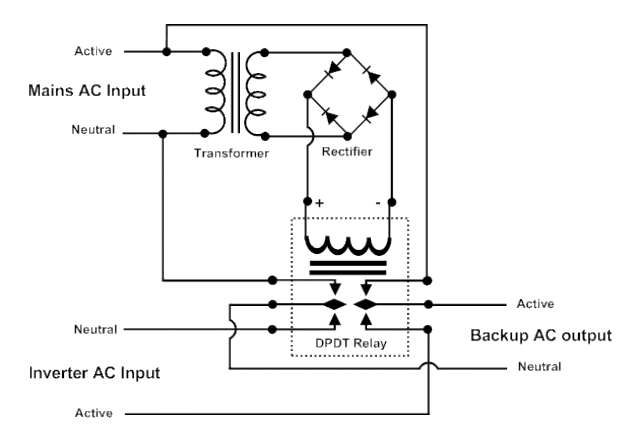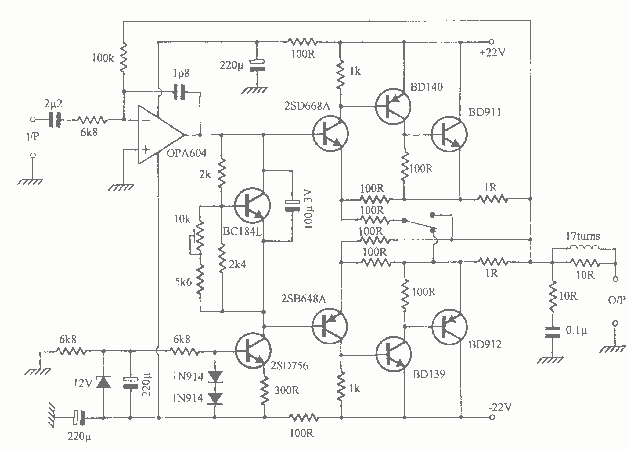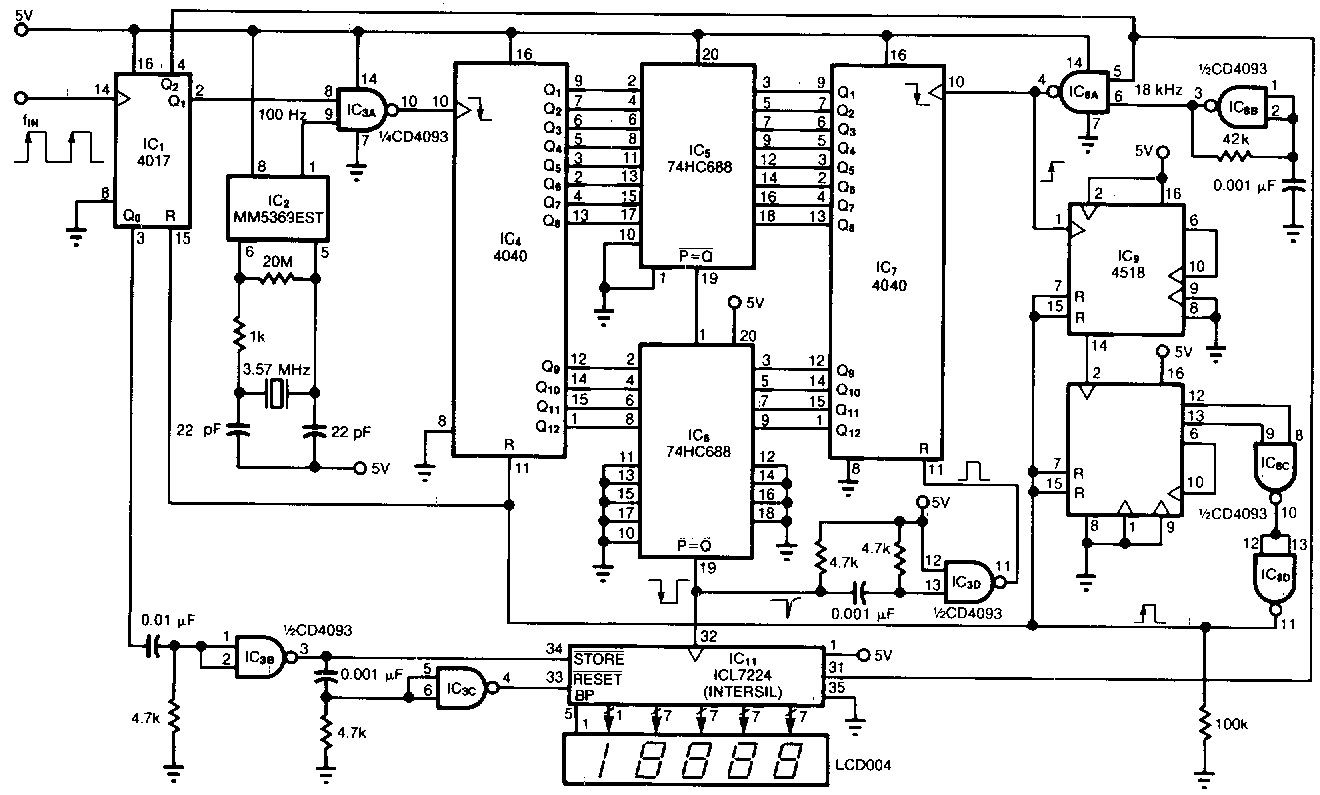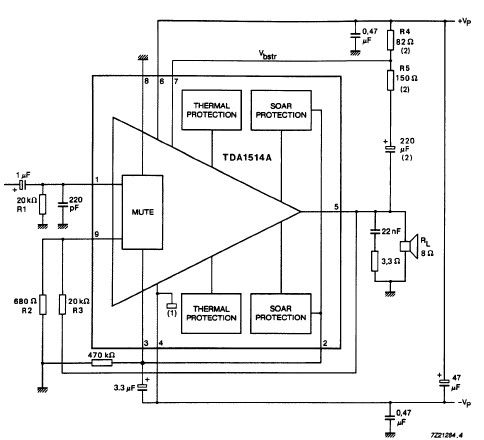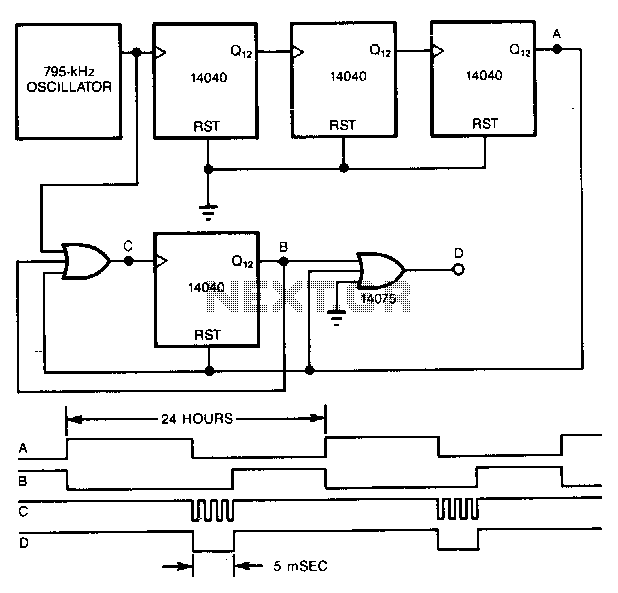
Low Noise Design Schematics
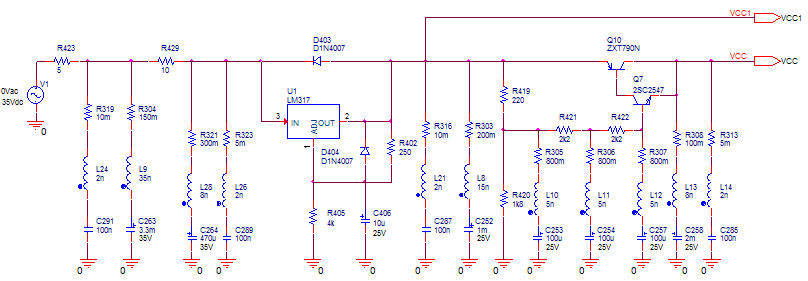
The concept of distributed active RIAA correction and the use of negative feedback to linearize the input stage is appealing. However, the original design by Collin has significant flaws, including poor power supply rejection ratio (PSRR) in the input stage. To mitigate hum and noise artifacts in the signal chain, a solid power supply is essential. A Jung regulator was added to the same board, powered by a 24V wall wart, necessitating additional circuitry for power supply splitting. A TLE2426 rail splitter was chosen, which effectively manages balanced rail current and any imbalance flows through the virtual ground it creates. Caution is advised in applications due to existing current imbalances from the input stage JFETs. The TLE2426 may generate some heat, but it is manageable. However, extending the design to more paralleled JFETs could lead to significant power dissipation issues. Construction should utilize high-quality components such as polypropylene capacitors, metal film resistors, and low-noise operational amplifiers (AD797, LT1115, LT1128, LME49710, OPA211 on an SMD adaptor) to ensure good results. The relays employed are 12V DIP case models. It is advisable to mute the preamps during power up/down or gain switching to prevent loud thumps in the speakers. For this design, the dynamic range (headroom) is approximately 22dB at 1KHz with a maximum gain of 64dB and +/-17V supplies. While this performance is adequate, it does present some audible issues. The equivalent input noise is around 0.9nV/√Hz, which is quite good for a moving magnet (MM) cartridge but less suitable for moving coil (MC) cartridges as hiss is noticeable at the 64dB gain setting. For low output MC cartridges, the HPS 2.0 is recommended. The HPS 2.0 features four 2SK170 low-noise JFETs in the input stage, theoretically reducing input noise to about 1-1.2nV/√Hz, plus the source resistor contribution of 0.4nV/√Hz. A dedicated power supply was also added to replace the wall wart and TLE2426 rail splitter, designed as a separate unit to minimize hum. Both PCBs fit in the same extruded aluminum case as the HPS 1.0, requiring two 5-pin connectors and appropriate cabling for power supply connection. The HPS 2.0 retains the same gain and dynamic range as HPS 1.0 but features significantly improved noise performance. The equivalent input noise is around 0.6-0.7nV/√Hz, making it suitable for MC cartridges with outputs as low as 0.5-0.7mV at 5cm/sec.
The circuit design incorporates a distributed active RIAA correction topology, enhancing audio fidelity through precise equalization of frequency response. The use of negative feedback in the input stage serves to linearize amplification, reducing distortion and improving overall sound quality. The Jung regulator's implementation ensures a stable power supply, crucial for minimizing noise interference in sensitive audio applications. The TLE2426 rail splitter efficiently manages the power distribution across the circuit, generating balanced positive and negative rails while maintaining a virtual ground reference.
The choice of components is critical; polypropylene capacitors provide low distortion and high frequency response, while metal film resistors offer superior thermal stability and low noise characteristics. Low-noise operational amplifiers are selected to further enhance the signal integrity, ensuring that the audio path remains clean and free from extraneous noise. The inclusion of relays for muting during power transitions prevents audible thumps, protecting connected speakers from potential damage.
The dynamic range of the circuit is a key specification, indicating its ability to handle a wide range of audio signals without distortion or clipping. The measured equivalent input noise levels are indicative of the circuit's performance, particularly in relation to different cartridge types. The design's adaptability for both MM and MC cartridges highlights its versatility, although it is important to note the limitations in noise performance for low output MC applications.
Overall, the HPS 1.0 and HPS 2.0 designs exemplify a well-thought-out approach to high-fidelity audio preamplification, balancing performance, and practicality while addressing common pitfalls in audio circuit design. The transition from HPS 1.0 to HPS 2.0 illustrates an evolution in design philosophy, focusing on enhanced noise performance and reliability in audio signal processing.I liked the idea of distributed active RIAA correction and also the concept of using negative feedback to linearize the input stage. Now, the original Collin design has a few significant flaws (openly admitted by the author in the same article), one of them being the very poor PSRR in the input stage.
To avoid hum and other noise artifacts to enter the signal chain, this design calls for a solid power supply, much better than the original. So I decided to add a Jung regulator on the same board. The plan was to feed HPS 1. 0 from a 24V wall wart, so some extra circuitry is required to split the power supply. I decided for a TLE2426 rail splitter. This little circuit works great and it`s ideal for balanced rails current; any imbalance flows straight through the virtual ground created by this circuit, so I would advise to be careful in your applications. The HPS 1. 0 currents are already imbalanced by the input stage JFETs, dragging current from the positive supply only.
The TLE2426 gets a little hot, but nothing to worry about. However, further extending the same concept to more paralleled JFETs may create some serious power dissipation issues. There`s not much to tell about construction; just use good quality components (polypropylene caps, metal film resistors) and low noise opamps (AD797 or LT1115, LT1128, LME49710, OPA211 on a SMD adaptor) and the good results are guaranteed.
The relays are DIP case 12V models. It is a good idea to mute the preamps before powering up/down or switching the gain to avoid a large thump into the speakers. For this build, the dynamic range (aka the headroom) is around 22dB at 1KHz, for the max gain of 64dB and +/-17V supplies.
This is not bad, but has a certain audible as you`ll find later on this page. As you will find in the Measurement sections, the equivalent input noise of this construction is about 0. 9nV/rtHz. This is very good for a MM cartridge (the NAD PP3 preamp has 8nV/rtHz for the MM input) but not that great for MC.
The hiss is clearly audible, on the 64dB gain setting, even in not very sensitive speakers. Therefore, even if it has the required gain, I cannot recommend this construction for low output MC cartridges; you may want to look at the HPS 2. 0 below for that. Although the Jung regulator helps in reducing the hum and noise artifacts injection in the input stage, some residuals (captured from the supply input wiring and the ambient, the case is aluminum) are still slightly audible; again, refer to HPS 2.
0 for a low output MC cartridge. - HPS 2. 0 uses 4 2SK170 low noise JFETs in the input stage. The equivalent input noise of the input stage is inversely proportional to the square of the number of paralleled input devices; it is therefore expected, theoretically, HPS 2. 0 to have half the noise of a single 2SK170 input stage (1-1. 2nV/rtHz) plus the contribution of the source resistor (10ohm, 0. 4nV/rtHz). - A dedicated power supply (to replace the wall wart and the TLE2426 rail splitter) was added as well.
To keep hum to a minimum, this supply was designed as a separate unit. Both PCBs will fit each in the same extruded aluminum case as for HPS 1. 0. Two 5 pin connectors and an appropiate cable are required to connect the power supply to the preamp. The same construction details as for HPS 1. 0 apply. HPS 2. 0 has the same gain, the same dynamic range as HPS 1. 0 but a much improved noise performance. As you will find in the Measurements secton, the equivalent input noise is around 0. 6-0. 7nV/rtHz; it can be therefore successfully used with MC cartridges down to 0. 5-0. 7mV output at 5cm/sec. The only criticism I was able to hear about HPS 1. 0 and 2. 0 (beyond the regular grumble 🔗 External reference
The circuit design incorporates a distributed active RIAA correction topology, enhancing audio fidelity through precise equalization of frequency response. The use of negative feedback in the input stage serves to linearize amplification, reducing distortion and improving overall sound quality. The Jung regulator's implementation ensures a stable power supply, crucial for minimizing noise interference in sensitive audio applications. The TLE2426 rail splitter efficiently manages the power distribution across the circuit, generating balanced positive and negative rails while maintaining a virtual ground reference.
The choice of components is critical; polypropylene capacitors provide low distortion and high frequency response, while metal film resistors offer superior thermal stability and low noise characteristics. Low-noise operational amplifiers are selected to further enhance the signal integrity, ensuring that the audio path remains clean and free from extraneous noise. The inclusion of relays for muting during power transitions prevents audible thumps, protecting connected speakers from potential damage.
The dynamic range of the circuit is a key specification, indicating its ability to handle a wide range of audio signals without distortion or clipping. The measured equivalent input noise levels are indicative of the circuit's performance, particularly in relation to different cartridge types. The design's adaptability for both MM and MC cartridges highlights its versatility, although it is important to note the limitations in noise performance for low output MC applications.
Overall, the HPS 1.0 and HPS 2.0 designs exemplify a well-thought-out approach to high-fidelity audio preamplification, balancing performance, and practicality while addressing common pitfalls in audio circuit design. The transition from HPS 1.0 to HPS 2.0 illustrates an evolution in design philosophy, focusing on enhanced noise performance and reliability in audio signal processing.I liked the idea of distributed active RIAA correction and also the concept of using negative feedback to linearize the input stage. Now, the original Collin design has a few significant flaws (openly admitted by the author in the same article), one of them being the very poor PSRR in the input stage.
To avoid hum and other noise artifacts to enter the signal chain, this design calls for a solid power supply, much better than the original. So I decided to add a Jung regulator on the same board. The plan was to feed HPS 1. 0 from a 24V wall wart, so some extra circuitry is required to split the power supply. I decided for a TLE2426 rail splitter. This little circuit works great and it`s ideal for balanced rails current; any imbalance flows straight through the virtual ground created by this circuit, so I would advise to be careful in your applications. The HPS 1. 0 currents are already imbalanced by the input stage JFETs, dragging current from the positive supply only.
The TLE2426 gets a little hot, but nothing to worry about. However, further extending the same concept to more paralleled JFETs may create some serious power dissipation issues. There`s not much to tell about construction; just use good quality components (polypropylene caps, metal film resistors) and low noise opamps (AD797 or LT1115, LT1128, LME49710, OPA211 on a SMD adaptor) and the good results are guaranteed.
The relays are DIP case 12V models. It is a good idea to mute the preamps before powering up/down or switching the gain to avoid a large thump into the speakers. For this build, the dynamic range (aka the headroom) is around 22dB at 1KHz, for the max gain of 64dB and +/-17V supplies.
This is not bad, but has a certain audible as you`ll find later on this page. As you will find in the Measurement sections, the equivalent input noise of this construction is about 0. 9nV/rtHz. This is very good for a MM cartridge (the NAD PP3 preamp has 8nV/rtHz for the MM input) but not that great for MC.
The hiss is clearly audible, on the 64dB gain setting, even in not very sensitive speakers. Therefore, even if it has the required gain, I cannot recommend this construction for low output MC cartridges; you may want to look at the HPS 2. 0 below for that. Although the Jung regulator helps in reducing the hum and noise artifacts injection in the input stage, some residuals (captured from the supply input wiring and the ambient, the case is aluminum) are still slightly audible; again, refer to HPS 2.
0 for a low output MC cartridge. - HPS 2. 0 uses 4 2SK170 low noise JFETs in the input stage. The equivalent input noise of the input stage is inversely proportional to the square of the number of paralleled input devices; it is therefore expected, theoretically, HPS 2. 0 to have half the noise of a single 2SK170 input stage (1-1. 2nV/rtHz) plus the contribution of the source resistor (10ohm, 0. 4nV/rtHz). - A dedicated power supply (to replace the wall wart and the TLE2426 rail splitter) was added as well.
To keep hum to a minimum, this supply was designed as a separate unit. Both PCBs will fit each in the same extruded aluminum case as for HPS 1. 0. Two 5 pin connectors and an appropiate cable are required to connect the power supply to the preamp. The same construction details as for HPS 1. 0 apply. HPS 2. 0 has the same gain, the same dynamic range as HPS 1. 0 but a much improved noise performance. As you will find in the Measurements secton, the equivalent input noise is around 0. 6-0. 7nV/rtHz; it can be therefore successfully used with MC cartridges down to 0. 5-0. 7mV output at 5cm/sec. The only criticism I was able to hear about HPS 1. 0 and 2. 0 (beyond the regular grumble 🔗 External reference
